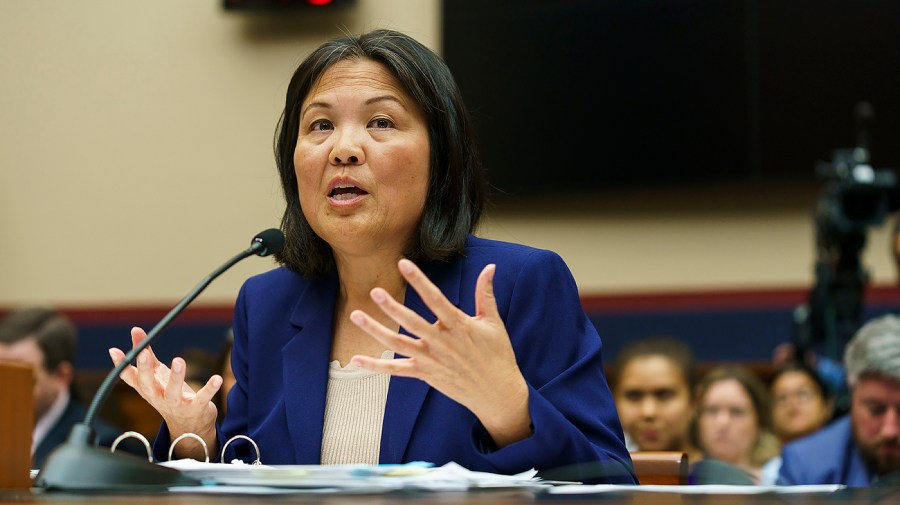Business
DOL cracks down on child labor while states loosen laws on July 28, 2023 at 3:26 pm Business News | The Hill

The Department of Labor (DOL) is cracking down on child labor violations even as multiple states have taken steps to loosen regulations around teenagers in the workplace.
At least 11 states have recently sought to make it easier to get minors in the workforce, including this year both Arkansas and Iowa, the latter of which moved to allow teenagers into meat packing facilities and for those as young as 16 to bartend.
Proponents say the changes will help young workers acquire valuable life skills and that parents should be the ones to decide when their kids are ready for a particular job.
But child advocates fear putting teenagers into increasingly dangerous work environments that are difficult to regulate and vulnerable to exploitation.
And on Thursday, the DOL and its Interagency Task Force to Combat Child Labor Exploitation announced new actions it will be taking after it found that child labor violations have risen 69 percent between 2018 and last year.
“Child labor is an issue that gets to the heart of who we are as a country and who we want to be. Like the President, we believe that any child working in a dangerous or hazardous environment is one child too many,” acting Secretary of Labor Julie Su said.
State efforts to change child labor laws come amid a tight labor market and a workers shortage.
“A lot of the legislators are citing that as a reason for weakening protections against child labor,” said Reid Maki, director of child labor advocacy for the National Consumers League and coordinator of the Child Labor Coalition. “We don’t think that’s a valid reason. We really don’t understand why you would want to balance the labor shortage against the backs of our vulnerable teen workers.”
In May, Iowa Gov. Kim Reynolds (R) signed a bill to expand the number of hours and places a teenager can work, allowing 14- and 15-year-olds to work in industrial areas such as meat coolers.
“With this legislation, Iowa joins 20 other states in providing tailored, common sense labor provisions that allow young adults to develop their skills in the workforce,” Reynolds said after signing the law.
“In Iowa, we understand there is dignity in work and we pride ourselves on our strong work ethic. Instilling those values in the next generation and providing opportunities for young adults to earn and save to build a better life should be available,” she added.
In Arkansas, Gov. Sarah Huckabee Sanders (R) in March signed the Youth Hiring Act of 2023, doing away with the requirement that children under the of age 16 must get permission from the state government to work.
Nick Stehle, vice president of communications for the Foundation for Government Accountability, a group that led the push for reform in Arkansas, stressed the importance working young can make on a person’s life.
“Keeping a schedule and having to collaborate with other people, having to work with other people and discovering your skills and shortcomings while you’re still you’re still very young, those are just all lessons that not only complement what you’re learning in the classroom, they add some real world context to it,” Stehle said.
Stehle emphasized all the reforms his group supported were in line with federal child labor laws.
“There’s been allegations that this is about making it so that teenagers can work in dangerous jobs or that they can work really late at night, stuff like that. And none of that is true,” he said.
Meanwhile, the DOL says it concluded 765 child labor cases between Oct. 1 and July 20. finding 4,474 children were employed in violation of federal standards.
Federal investigators found one instance in which the owner of six Nevada Sonic locations had committed more than 170 child labor violations, including employing 14- and 15-year-olds to operate deep fryers, work more hours than allowed and work at hours not allowed under federal guidelines.
In one tragic case that made national headlines earlier this month, a 16-year-old boy from Guatemala was killed in an on-the-job accident at a Mississippi poultry plant. Workers under the age of 18 are not allowed in such facilities for safety reasons, and DOL said at the time that it is investigating.
DOL plans to partner with other government offices such as the Office of Refugee Resettlement to give training on how to identify and report instances of child labor violations and update their guidelines.
It is also teaming up with the Department of Agriculture to demand that the country’s 18 largest meat and poultry processors take steps such as find out if illegal child labor is used anywhere in their supply chain in order to combat exploitive practices.
One of the causes experts say is behind the increase in child labor violations is the uptick in unaccompanied minors coming into the U.S.
“These are very vulnerable young people that need money and they may — they may be sending money back to family and Central America and Mexico. So they have a desperate need for money,” Maki said.
A New York Times investigation earlier this year showed migrant children, some as young as 13, at the brunt of work that violates federal standards.
In response, the U.S. will be working with the embassies of Colombia, El Salvador, Guatemala, Honduras and Mexico to take steps to combat child labor and educate migrants on the problem.
The increase in child labor violations combined with the changes to state laws have concerned advocates who are afraid the problem will only get worse.
“Our child labor laws are very common sense laws that really serve two purposes. They make sure children are not working in highly dangerous and hazardous jobs and that the work they do does not interfere with their development and their schooling,” said Laura Padin, director of work structures at the National Employment Law Project.
“These laws serve a really important purpose. It’s really disturbing to see this happening now,” Padin added.
Experts contend the new laws will harm poor children, children of color and undocumented children who would take these jobs out of necessity to survive.
“They’re seeking to expand employment to workers that can be paid less in order to keep wages low and still maintain the same levels of employment,” said Nina Mast, a state economic analyst for the Economic Policy Institute. “At the same time, you also have our broken immigration system that has resulted in many unaccompanied migrant youth in this country without work authorization and sort of compelled by their economic circumstances to work. And that’s really a recipe for exploitation because they lack sort of the legal rights and support to demand safe and age-appropriate work.”
Education, Administration, Business, State Watch, child labor laws The Department of Labor (DOL) is cracking down on child labor violations even as multiple states have taken steps to loosen regulations around teenagers in the workplace. At least 11 states have recently sought to make it easier to get minors in the workforce, including this year both Arkansas and Iowa, the latter of which…
Business
Google Accused Of Favoring White, Asian Staff As It Reaches $28 Million Deal That Excludes Black Workers

Google has tentatively agreed to a $28 million settlement in a California class‑action lawsuit alleging that white and Asian employees were routinely paid more and placed on faster career tracks than colleagues from other racial and ethnic backgrounds.
- A Santa Clara County Superior Court judge has granted preliminary approval, calling the deal “fair” and noting that it could cover more than 6,600 current and former Google workers employed in the state between 2018 and 2024.

How The Discrimination Claims Emerged
The lawsuit was brought by former Google employee Ana Cantu, who identifies as Mexican and racially Indigenous and worked in people operations and cloud departments for about seven years. Cantu alleges that despite strong performance, she remained stuck at the same level while white and Asian colleagues doing similar work received higher pay, higher “levels,” and more frequent promotions.
Cantu’s complaint claims that Latino, Indigenous, Native American, Native Hawaiian, Pacific Islander, and Alaska Native employees were systematically underpaid compared with white and Asian coworkers performing substantially similar roles. The suit also says employees who raised concerns about pay and leveling saw raises and promotions withheld, reinforcing what plaintiffs describe as a two‑tiered system inside the company.
Why Black Employees Were Left Out
Cantu’s legal team ultimately agreed to narrow the class to employees whose race and ethnicity were “most closely aligned” with hers, a condition that cleared the path to the current settlement.

The judge noted that Black employees were explicitly excluded from the settlement class after negotiations, meaning they will not share in the $28 million payout even though they were named in earlier versions of the case. Separate litigation on behalf of Black Google employees alleging racial bias in pay and promotions remains pending, leaving their claims to be resolved in a different forum.
What The Settlement Provides
Of the $28 million total, about $20.4 million is expected to be distributed to eligible class members after legal fees and penalties are deducted. Eligible workers include those in California who self‑identified as Hispanic, Latinx, Indigenous, Native American, American Indian, Native Hawaiian, Pacific Islander, and/or Alaska Native during the covered period.
Beyond cash payments, Google has also agreed to take steps aimed at addressing the alleged disparities, including reviewing pay and leveling practices for racial and ethnic gaps. The settlement still needs final court approval at a hearing scheduled for later this year, and affected employees will have a chance to opt out or object before any money is distributed.
H2: Google’s Response And The Broader Stakes
A Google spokesperson has said the company disputes the allegations but chose to settle in order to move forward, while reiterating its public commitment to fair pay, hiring, and advancement for all employees. The company has emphasized ongoing internal audits and equity initiatives, though plaintiffs argue those efforts did not prevent or correct the disparities outlined in the lawsuit.
For many observers, the exclusion of Black workers from the settlement highlights the legal and strategic complexities of class‑action discrimination cases, especially in large, diverse workplaces. The outcome of the remaining lawsuit brought on behalf of Black employees, alongside this $28 million deal, will help define how one of the world’s most powerful tech companies is held accountable for alleged racial inequities in pay and promotion.
Business
Luana Lopes Lara: How a 29‑Year‑Old Became the Youngest Self‑Made Woman Billionaire

At just 29, Luana Lopes Lara has taken a title that usually belongs to pop stars and consumer‑app founders.
Multiple business outlets now recognize her as the world’s youngest self‑made woman billionaire, after her company Kalshi hit an 11 billion dollar valuation in a new funding round.
That round, a 1 billion dollar Series E led by Paradigm with Sequoia Capital, Andreessen Horowitz, CapitalG and others participating, instantly pushed both co‑founders into the three‑comma club. Estimates place Luana’s personal stake at roughly 12 percent of Kalshi, valuing her net worth at about 1.3 billion dollars—wealth tied directly to equity she helped create rather than inheritance.

Kalshi itself is a big part of why her ascent matters.
Founded in 2019, the New York–based company runs a federally regulated prediction‑market exchange where users trade yes‑or‑no contracts on real‑world events, from inflation reports to elections and sports outcomes.
As of late 2025, the platform has reached around 50 billion dollars in annualized trading volume, a thousand‑fold jump from roughly 300 million the year before, according to figures cited in TechCrunch and other financial press. That hyper‑growth convinced investors that event contracts are more than a niche curiosity, and it is this conviction—expressed in billions of dollars of new capital—that turned Luana’s share of Kalshi into a billion‑dollar fortune almost overnight.
Her path to that point is unusually demanding even by founder standards. Luana grew up in Brazil and trained at the Bolshoi Theater School’s Brazilian campus, where reports say she spent up to 13 hours a day in class and rehearsal, competing for places in a program that accepts fewer than 3 percent of applicants. After a stint dancing professionally in Austria, she pivoted into academics, enrolling at the Massachusetts Institute of Technology to study computer science and mathematics and later completing a master’s in engineering.
During summers she interned at major firms including Bridgewater Associates and Citadel, gaining a front‑row view of how global macro traders constantly bet on future events—but without a simple, regulated way for ordinary people to do the same.

That realization shaped Kalshi’s founding thesis and ultimately her billionaire status. Together with co‑founder Tarek Mansour, whom she met at MIT, Luana spent years persuading lawyers and U.S. regulators that a fully legal event‑trading exchange could exist under commodities law. Reports say more than 60 law firms turned them down before one agreed to help, and the company then spent roughly three years in licensing discussions with the Commodity Futures Trading Commission before gaining approval. The payoff is visible in 2025’s numbers: an 11‑billion‑dollar valuation, a 1‑billion‑dollar fresh capital injection, and a founder’s stake that makes Luana Lopes Lara not just a compelling story but a data point in how fast wealth can now be created at the intersection of finance, regulation, and software.
Business
Harvard Grads Jobless? How AI & Ghost Jobs Broke Hiring

America’s job market is facing an unprecedented crisis—and nowhere is this more painfully obvious than at Harvard, the world’s gold standard for elite education. A stunning 25% of Harvard’s MBA class of 2025 remains unemployed months after graduation, the highest rate recorded in university history. The Ivy League dream has become a harsh wakeup call, and it’s sending shockwaves across the professional landscape.

Jobless at the Top: Why Graduates Can’t Find Work
For decades, a Harvard diploma was considered a golden ticket. Now, graduates send out hundreds of résumés, often from their parents’ homes, only to get ghosted or auto-rejected by machines. Only 30% of all 2025 graduates nationally have found full-time work in their field, and nearly half feel unprepared for the workforce. “Go to college, get a good job“—that promise is slipping away, even for the smartest and most driven.
Tech’s Iron Grip: ATS and AI Gatekeepers
Applicant tracking systems (ATS) and AI algorithms have become ruthless gatekeepers. If a résumé doesn’t perfectly match the keywords or formatting demanded by the bots, it never reaches human eyes. The age of human connection is gone—now, you’re just a data point to be sorted and discarded.
AI screening has gone beyond basic qualifications. New tools “read” for inferred personality and tone, rejecting candidates for reasons they never see. Worse, up to half of online job listings may be fake—created simply to collect résumés, pad company metrics, or fulfill compliance without ever intending to fill the role.
The Experience Trap: Entry-Level Jobs Require Years
It’s not just Harvard grads who are hurting. Entry-level roles demand years of experience, unpaid internships, and portfolios that resemble a seasoned professional, not a fresh graduate. A bachelor’s degree, once the key to entry, is now just the price of admission. Overqualified candidates compete for underpaid jobs, often just to survive.
One Harvard MBA described applying to 1,000 jobs with no results. Companies, inundated by applications, are now so selective that only those who precisely “game the system” have a shot. This has fundamentally flipped the hiring pyramid: enormous demand for experience, shrinking chances for new entrants, and a brutal gauntlet for anyone not perfectly groomed by internships and coaching.
Burnout Before Day One
The cost is more than financial—mental health and optimism are collapsing among the newest generation of workers. Many come out of elite programs and immediately end up in jobs that don’t require degrees, or take positions far below their qualifications just to pay the bills. There’s a sense of burnout before careers even begin, trapping talent in a cycle of exhaustion, frustration, and disillusionment.
Cultural Collapse: From Relationships to Algorithms
What’s really broken? The culture of hiring itself. Companies have traded trust, mentorship, and relationships for metrics, optimizations, and cost-cutting. Managers no longer hire on potential—they rely on machines, rankings, and personality tests that filter out individuality and reward those who play the algorithmic game best.
AI has automated the very entry-level work that used to build careers—research, drafting, and analysis—and erased the first rung of the professional ladder for thousands of new graduates. The result is a workforce filled with people who know how to pass tests, not necessarily solve problems or drive innovation.
The Ghost Job Phenomenon
Up to half of all listings for entry-level jobs may be “ghost jobs”—positions posted online for optics, compliance, or future needs, but never intended for real hiring. This means millions of job seekers spend hours on applications destined for digital purgatory, further fueling exhaustion and cynicism.
Not Lazy—Just Locked Out
Despite the headlines, the new class of unemployed graduates is not lazy or entitled—they are overqualified, underleveraged, and battered by a broken process. Harvard’s brand means less to AI and ATS systems than the right keyword or résumé format. Human judgment has been sidelined; individuality is filtered out.

What’s Next? Back to Human Connection
Unless companies rediscover the value of human potential, mentorship, and relationships, the job search will remain a brutal numbers game—one that even the “best and brightest” struggle to win. The current system doesn’t just hurt workers—it holds companies back from hiring bold, creative talent who don’t fit perfect digital boxes.
Key Facts:
- 25% of Harvard MBAs unemployed, highest on record
- Only 30% of 2025 grads nationwide have jobs in their field
- Nearly half of grads feel unprepared for real work
- Up to 50% of entry-level listings are “ghost jobs”
- AI and ATS have replaced human judgment at most companies
If you’ve felt this struggle—or see it happening around you—share your story in the comments. And make sure to subscribe for more deep dives on the reality of today’s economy and job market.
This is not just a Harvard problem. It’s a sign that America’s job engine is running on empty, and it’s time to reboot—before another generation is locked out.

 Entertainment2 weeks ago
Entertainment2 weeks agoWicked Sequel Disappoints Fans: Audience Verdict on For Good

 News4 weeks ago
News4 weeks agoYolanda Adams Questions Traditional Views on God’s Gender, Audience Reacts

 Entertainment2 weeks ago
Entertainment2 weeks agoAriana & Cynthia Say They’re in a ‘Non‑Demi Curious, Semi‑Binary’ Relationship… WTF Does That Even Mean?

 News3 weeks ago
News3 weeks agoEpstein Files to Be Declassified After Trump Order

 News4 weeks ago
News4 weeks agoTrump Throws Epstein Files at Clinton’s Door

 Entertainment4 weeks ago
Entertainment4 weeks agoAriana Grande’s Red Carpet: When Fans Forget Boundaries

 Entertainment4 weeks ago
Entertainment4 weeks agoHollywood’s Kiss or Miss Policy: Why Saying No Got Neal McDonough Blackballed

 Entertainment3 weeks ago
Entertainment3 weeks agoJimmy Cliff, Reggae Legend and Star of ‘The Harder They Come,’ Dies at 81




























